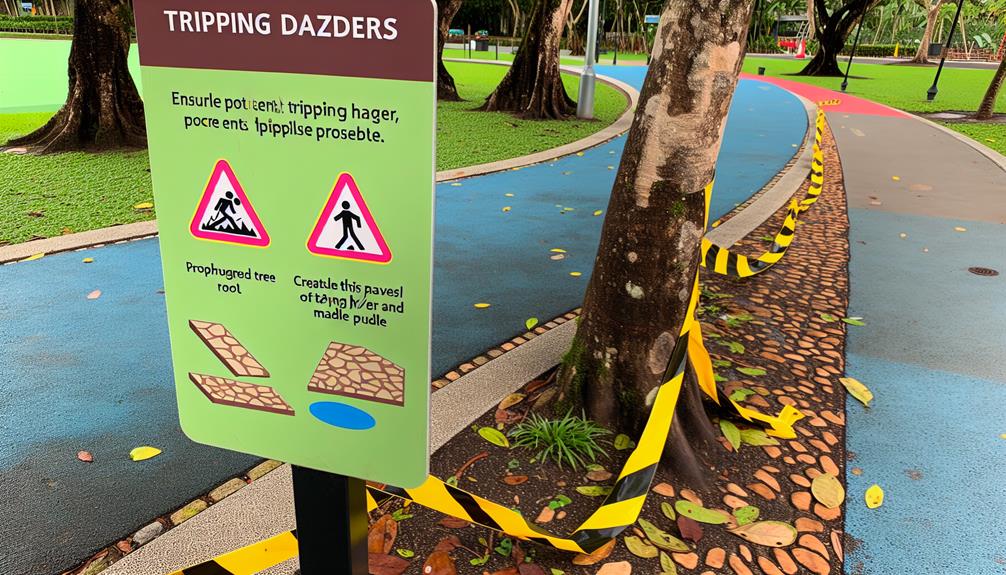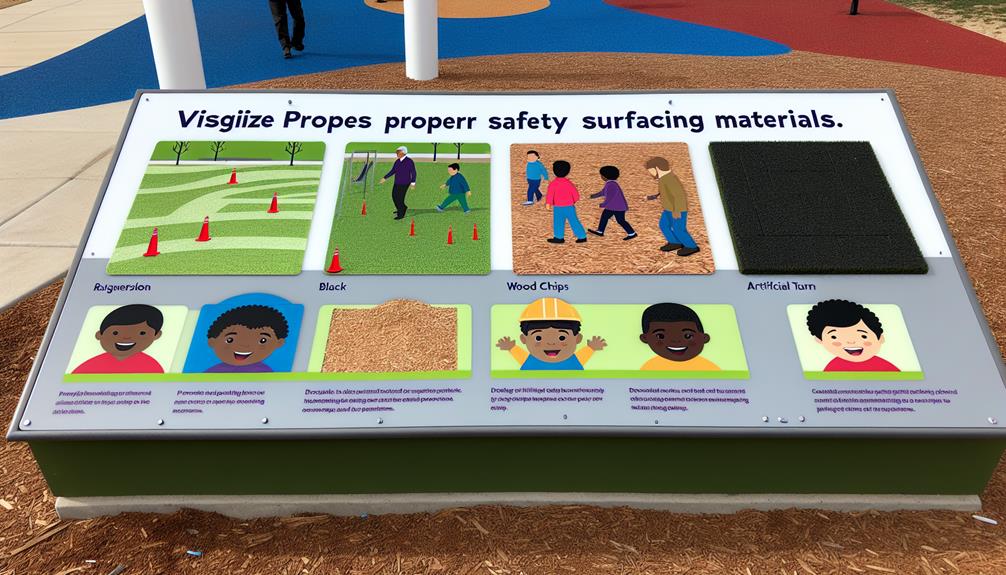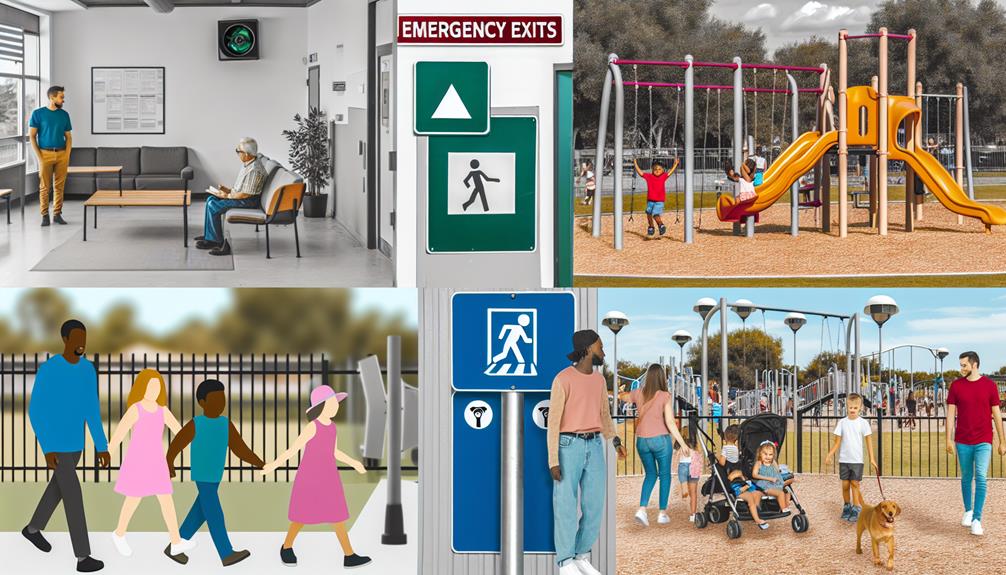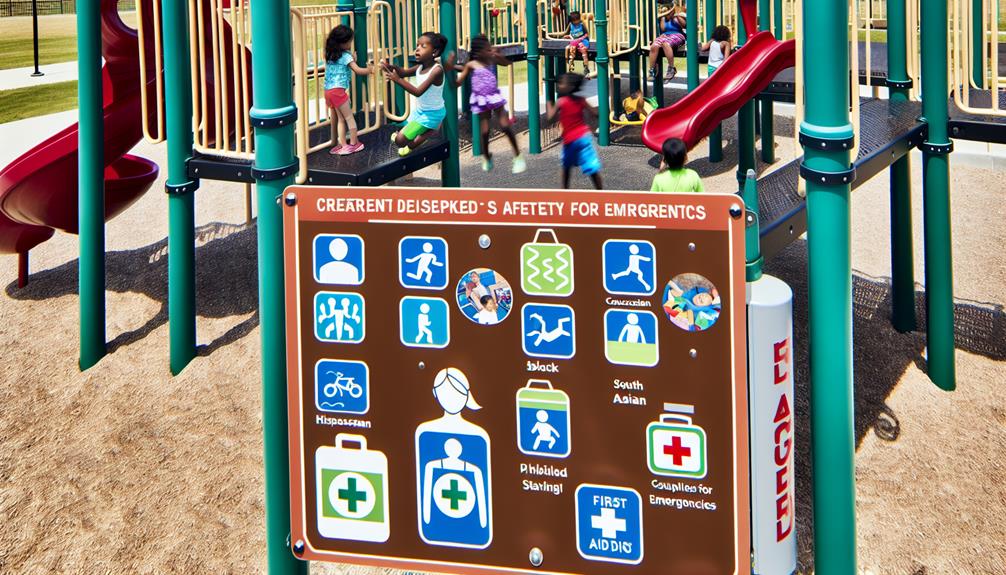When it comes to public parks, keeping visitors safe is top priority. From creating separate areas for different age groups to placing shade strategically, many steps are taken to ensure a secure environment for everyone.
Preventing tripping hazards, swiftly addressing any dangers, and using the right materials for playground surfaces are crucial. But, have you ever thought about the significance of checking equipment safety and conducting thorough safety assessments in parks?
These extra precautions play a vital role in improving the overall safety and fun in public parks.
Key Takeaways
Creating Age Group Zones is key to ensuring everyone has a great time at the park. By setting up areas tailored to different abilities and interests, visitors can find just what they need.
Strategic Shade Placement is a smart move for protecting against the sun's rays and keeping guests comfortable throughout their visit.
Regular maintenance is crucial for keeping hazards at bay. By staying on top of repairs and promptly identifying risks, the park remains a safe space for all.
Safety Zones, clearly marked and with buffer areas between different sections, help prevent accidents and keep things running smoothly.
Quickly addressing any hazards that arise is essential. By promptly removing dangers, the park can maintain a safe environment for all its visitors.
Designated Age Group Areas
When it comes to making public parks safer and more enjoyable for everyone, having separate areas designated for different age groups is key. By creating distinct play zones tailored to specific age ranges, we significantly boost park safety. This setup allows young children to play without worrying about bumping into older, more energetic kids, reducing the risk of accidents and conflicts. Tailoring playground equipment and activities to each age group's developmental stage and abilities also minimizes the chances of injuries.
Setting up designated areas with buffer zones for specific age groups not only enhances park safety but also fosters a peaceful setting where children can play without feeling overwhelmed by older peers. These dedicated zones make it easier for caregivers to keep an eye on kids, ensuring they're in a space suited to their needs. Moreover, by offering zones for various age groups, the overall park experience becomes more engaging as visitors can partake in activities that are both stimulating and enjoyable, promoting inclusivity and fun for all. Establishing these age-specific areas is a proactive measure to guarantee that everyone can have a safe and pleasant time at the park.
Strategic Shade Placement
When it comes to making public parks more enjoyable and safe, placing shaded areas strategically is key. By strategically locating shaded spots in parks, we can greatly reduce the risk of sun-related health issues for visitors. This not only boosts comfort but also encourages people to stay longer and engage more with the community.
To get the most out of shaded areas in parks, here are some things to consider:
- Natural Shade: Make the most of trees and greenery for natural shade. It's eco-friendly and blends beautifully with the park's surroundings.
- Shade Structures: Install structures, permanent or temporary, to provide consistent shade all day long.
- Seating Arrangement: Arrange seating strategically in shaded areas to invite visitors to relax and enjoy the cool spots.
Tripping Hazard Prevention

Keeping our parks safe for everyone to enjoy is a top priority. We need to make sure there are no tripping hazards that could cause accidents. One way to do this is by using anchoring devices to secure park equipment like benches, picnic tables, and playground gear. These devices keep things stable and prevent them from tipping over, reducing the risk of injuries.
It's also crucial to maintain smooth pathways without sudden changes in elevation. This helps people move around the park safely without tripping or falling. Regular upkeep is key to preventing tripping hazards. Park staff should quickly clear away any debris, loose materials, or obstacles that could block the pathways and cause accidents. By staying on top of maintenance tasks, we can create a safer environment for everyone who visits our parks.
Buffer Zone Implementation
Setting up buffer zones in public parks is crucial for safety and organization. Make sure these zones are clearly marked to show different areas.
Place safety signs strategically within these zones to help visitors navigate and stay aware.
It's important to regularly inspect and upkeep the barriers around these zones to keep everyone safe while enjoying the park.
Zone Boundary Clarity
When it comes to making public parks safer and more organized, setting up buffer zones to clearly mark out different areas is key. These zones are crucial for separating sections like playgrounds for different age groups, which really boosts safety in play areas.
By having clear boundaries, the chances of accidents between kids of various ages are significantly lowered. Not only does having buffer zones ensure visitors' safety in the park, but it also helps with keeping things running smoothly and under control.
Defining these zone boundaries well leads to a more structured and orderly layout in the park, creating a safer space for everyone to have a good time.
Safety Signage Placement
When safety signs are strategically placed in buffer zones throughout public parks, they can significantly boost visitor safety and overall experience. These signs act as clear guides, marking boundaries between different areas designated for various age groups. By doing so, they help prevent conflicts and accidents, ensuring everyone can enjoy the park safely.
The placement of safety signage not only enhances safety but also improves the organization of the park. Visitors are directed to the appropriate zones, making their experience more structured and enjoyable. By utilizing safety signs effectively in buffer zones, public parks can create a secure environment that caters to the diverse needs of visitors while minimizing potential risks.
In my own park visits, I've seen how well-placed safety signs can make a difference in how people interact and move around the park. It provides a sense of direction and assurance, making the visit more pleasant for everyone. The practical use of safety signage in buffer zones truly elevates the park experience, ensuring that safety remains a top priority while enhancing the overall enjoyment for all visitors.
Barrier Maintenance Checks
Maintaining barriers in public parks is crucial for keeping visitors safe and preserving buffer zones. When you're out there checking on barriers, here's what you need to keep in mind:
- Look out for any wear and tear on the barriers already in place.
- Ensure that buffer zones are clearly marked and easy to see.
- Regularly test the stability and effectiveness of the barriers.
- Adjust buffer zones as needed to suit different park activities and visitor requirements.
Prompt Hazard Removal
Keeping an eye out for potential dangers is crucial to keeping public park visitors safe. Quickly fixing hazards in public parks is key to lowering the chances of accidents and injuries. By promptly addressing these issues, parks show they care about visitor safety and keeping the park in top shape. This proactive approach not only boosts park safety but also helps avoid possible legal problems.
Let's break down why it's essential to promptly deal with hazards in the table below:
| Advantages of Swift Hazard Removal |
|---|
| Decreases accident and injury risks |
| Shows dedication to visitor safety |
| Prevents potential legal issues |
Regular checks are vital for spotting hazards that need immediate attention. Whether it's a broken piece of equipment, a tripping hazard, or a slippery surface, fixing these problems right away is crucial for creating a safe and enjoyable park environment for everyone. By swiftly removing hazards, public parks can promote a culture of safety and improve the overall visitor experience.
Proper Surfacing Materials

When you're picking out materials for the playground floor, go for stuff that absorbs impact well, like rubber mulch or engineered wood chips. It really cuts down on the chances of kids getting hurt from falls.
Don't forget to keep up with maintenance and check the surface regularly to make sure it's still in good shape and provides enough cushioning to keep the little ones safe.
ASTM International has standards to help you choose the right materials, focusing on how well they absorb impact and making sure they're not harmful for a safe play area.
Impact Absorbing Surfaces
Having the right surfacing materials on playgrounds is key to keeping kids safe from falls. Materials like rubber mulch and engineered wood fiber help absorb impact, reducing the risk of injuries.
ASTM International sets strict standards for impact absorption to ensure playgrounds meet safety requirements. Loose-fill options such as rubber mulch and sand provide excellent cushioning, protecting children if they take a tumble.
These materials are essential for preventing serious head injuries and making playtime safer for kids.
Maintenance and Inspections
Keeping an eye on playground surfacing is crucial to keep kids safe and prevent injuries. Whether it's engineered wood fiber, rubber mulch, or synthetic turf, maintaining the right depth is key to cushion falls and reduce harm. ASTM International lays down standards for these materials to ensure they meet safety criteria and lower risks.
Regular check-ups help spot any hazards early on and fix them, creating a secure play area in public parks. Picking the proper surfacing material is vital for the well-being of park visitors. By staying on top of maintenance and inspections, safety standards are upheld, and accidents are prevented.
Equipment Safety Considerations
Maintaining playground equipment in top condition is key to ensuring a safe and enjoyable play environment for everyone at the park. Following safety protocols is crucial to protecting the well-being of all park visitors. Here are some important tips for keeping playground equipment safe:
- Regular Checks: Make it a habit to inspect playground equipment frequently to spot any broken parts or loose fittings that could be hazardous.
- Immediate Fixes: If you find any issues during inspections, act promptly by replacing any damaged components to prevent accidents and uphold a secure setting.
- Winter Care: During the colder months, take steps to shield playground equipment from harsh winter weather to avoid damage and extend its durability.
- Safety Upgrades: When playground equipment suffers significant damage that jeopardizes safety, prioritize replacing or upgrading these elements to ensure the protection of park guests.
Comprehensive Park Safety Evaluation

Ensuring the safety of everyone visiting the park is top priority. Thorough evaluations of park facilities are crucial for this. These evaluations help pinpoint potential hazards that could put visitors at risk. By looking closely at park layout, lighting, signage, surveillance systems, access control, and maintenance, we can gather valuable insights into how safe the park environment is.
When conducting a comprehensive park safety evaluation, it's essential to involve park staff, community members, and security experts. This collaborative approach ensures a well-rounded assessment. By tapping into the expertise of different parties, we gain a more complete picture of safety vulnerabilities. Moreover, these evaluations help assess the effectiveness of current safety measures and highlight areas needing improvement to boost park safety.
The data-driven findings from these evaluations form the basis for enhancing overall park security and safeguarding the well-being of all visitors. By using the insights gathered from detailed safety assessments, park authorities can implement targeted safety measures to address identified risks. This proactive approach contributes to creating a safer and more enjoyable park environment for everyone.
Frequently Asked Questions
How to Make Public Parks Safer?
To enhance safety in public parks, it's crucial to focus on lighting, regular checks, clear signs, well-trained staff, and surveillance. These elements team up like watchful guardians, deterring wrongdoing, spotting dangers, guiding visitors, handling emergencies, and ensuring a safe atmosphere for everyone.
How Can You Be Safe at a Park?
When you're out and about in the park, it's important to keep your wits about you. Stick to well-lit areas, steer clear of being alone, and don't hesitate to reach out to park staff if you notice anything off. It's always safer to walk in groups, follow the marked paths, and be aware of the emergency procedures just in case. Remember, having fun at the park should always go hand in hand with looking out for your own safety.
What Are the Safety Measures on a Playground?
Ensuring playground safety is a top priority. By regularly checking the equipment, following surface safety guidelines, choosing age-appropriate play structures, maintaining proper spacing, and providing vigilant supervision, we create a secure environment for children to have fun. These steps are crucial for preventing accidents and keeping kids safe while they play.
How Do You Increase the Safety in Parks for Children?
When it comes to keeping kids safe in parks, there are a few key things to keep in mind. Make sure to check the equipment regularly to spot any potential hazards. Use the right kind of surface material to cushion falls and reduce injuries. Create separate areas for different age groups to prevent accidents. Steer clear of risky stuff like trampolines or swinging gates that could lead to trouble. And most importantly, always keep a close eye on the little ones to avoid any mishaps. By following these simple guidelines, you can help ensure that everyone has a fun and safe time at the park.
